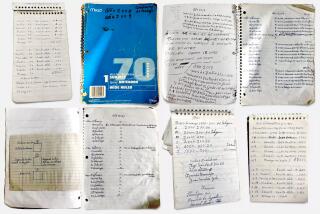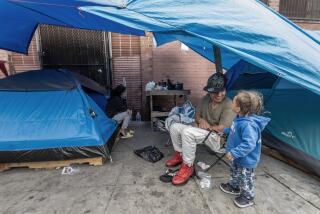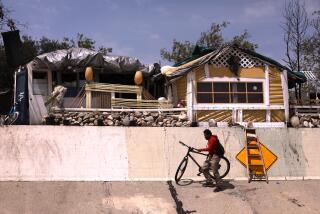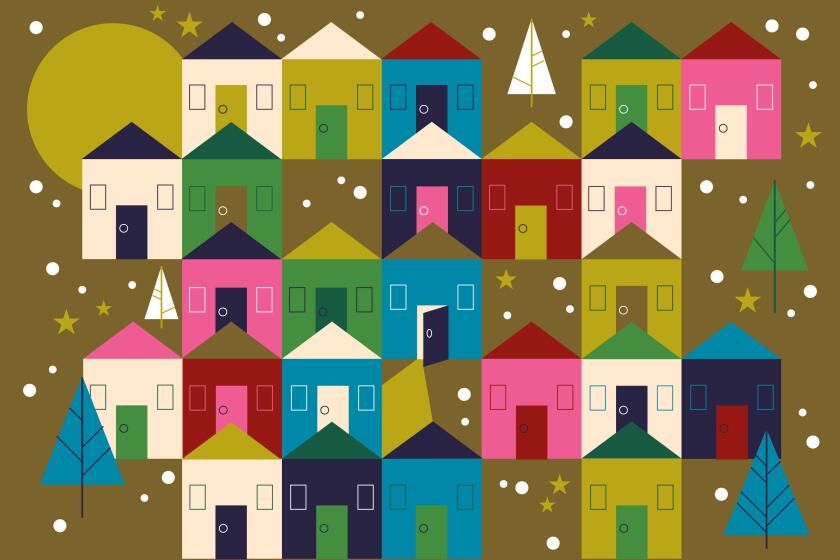In Mexico, Casita Linda is building hope
Reporting from San Miguel De Allende, Mexico â Just a few miles from multimillion-dollar homes in this central Mexican resort town, the countryside yields to dirt-floor lean-tos made of sticks, rocks, cardboard, blankets or tarps. If residents are lucky, they have a panel of sheet metal as the roof. Out here in the campo, most have no running water, no electricity, no sewer system, no paved roads. These people -- some of about 20 million Mexicans who live in extreme poverty -- hold title to small plots that average about 650 square feet, thanks to land reform policies initiated in 1934, but they have little money to build.
This weekend, however, a few of these families can be thankful for this: new houses designed by American architecture students and built for less than $7,000 apiece using local materials and volunteer labor. The project is called Casita Linda, a small organization similar to Habitat for Humanity made up of foreign retirees, average age 60, few of whom have experience in construction. Their goal: to help the local poorest of the poor, mainly single mothers, by âbuilding hope, one house at a time.â
When Casita Linda started seven years ago, the focus was on speed and cost. The first dozen homes were poured-in-place concrete slabs, walls that could be put up and joined like Legos in a few weeks for a 12-by-14-foot structure that cost slightly more than $2,000. The buildings were unpopular, though, because they were hot in summer, cold in winter and prone to mildew during the rainy season. Some families moved out, using the new structures as storage units.
The houses had limited indoor plumbing but no toilets or hot water. Residents used the showers as toilets, and they reverted to heating water over a wood fire outside and taking bucket baths.
Then earlier this year, Rhode Island School of Design professor Silvia Acosta and 14 students arrived in San Miguel for a monthlong collaboration with Casita Linda. Upon learning that the concrete homes werenât working out, the Rhode Island group began brainstorming, talking with residents of future houses and taking note of the materials used in the townâs architectural treasures, including its baroque church, el Oratorio de San Felipe Neri. They spent a week tweaking their design, ultimately devising a new plan based on an ancient material: adobe. âWe knew that adobe was used once, since the town is built from it,â Acosta says. âThere is a stigma assigned to it. Itâs considered material for the poor, and these families would not have gone back to using it. Thatâs what we heard often. Concrete showed signs of progress.â
But the group forged ahead. They had a hard time finding a supply of adobe until the professor met Pedro Urquiza, a local architect who specializes in adobe construction and uses what he calls âstabilizedâ bricks made of fine gravel, sand, clay and 10% asphalt oil.
Each brick costs 40 cents, tripling the total budget for a 500-square-foot house. Despite the higher cost and the stigma, adobe remained the material of choice because of its thermal qualities, flexibility in design and ease of use in construction.
âYou can shape adobe and cut the units as you go,â Acosta says. âWith concrete, youâre stuck with that shape.â
Instead of prohibitively expensive wooden beams for a flat roof, adobe bricks were used here as well, copying the vaulted bĂłveda ceilings in many San Miguel homes.
âIf the masonry blocks were the only thing weâre going to be using, the only way to produce a roof is by doing a dome or by doing a vault,â Acosta says.
This high ceiling results in a cooler home and provides space for a small loft for sleeping. The height of the walls also meant structural support was needed on the sides, so buttresses were added, hollowed out for more interior space.
The RISD groupâs prototype was built in Ejido de Tirado, a rural community just outside the road encircling San Miguel. Based on that model, Casita Linda began constructing more homes, hiring four local workers to supplement the labor of future homeowners and 20 or so expat volunteers.
âWeâre now doing a house every 25 days or so,â says Jean Gerber, the head of Casita Linda and a retired commercial real estate agent. âItâs a simple model, not that complex. We donât need high-end builders on this thing.â
::
On a Saturday in Ejido de Tirado, a dozen Casita Linda volunteers are finishing up house No. 19. They schlep 15-pound bricks, nail chicken wire to the wall in preparation for plastering and mix concrete.
Inside the house, Sergio Rio Mora is laying a brick floor over a bed of sand. This will be his house. Outside, under a blue tarp, his wife, Maria Dolores, makes tortillas -- lunch for the crew. Up on the roof, Miguel Cazarez Mendoza is laying adobe over a steel form for the bĂłveda. Last winter, he and his family were living in a roofless shack. They were the recipients of the RISD prototype, and heâs now one of four employees on the Casita Linda team.
âItâs much better now,â he says, smiling, adding that the new homes do a better job of protecting against the elements. âIt freezes out here.â
Charles Cunliffe, the head of construction (and a former banker), gathers all the volunteers and warns them to cover the adobe when they leave because itâs been raining. âAnd clean the cement off the tools,â he says. âTake five minutes today or two hours tomorrow.â
The volunteers -- a former Texas administrator for the Environmental Protection Agency, a computer specialist, an L.A. Superior Court commissioner and a Shakespearean scholar from the City University of New York -- all nod meekly. Then the talk turns to water, power and sanitation.
The groupâs plan is to go green in the design -- adding $200 solar panels that are strong enough to power not only lights so kids can do homework in the evening, but also an adobe convection oven to lessen the demand for firewood. A composting outhouse will produce natural fertilizer. Perhaps glass bricks in the walls, the volunteers say, would bring in more natural light.
âWe are altering the destiny of poverty,â Cunliffe says. âItâs changed the entire community. Kids are going to school now. They didnât before. These are the forgotten people.â
A few volunteers walk over to check out the next project, house No. 20. Itâs for a family of eight, all female. The mother is pregnant, and so is her 15-year-old daughter. Sheâs currently living in a doghouse-sized shed with soggy blankets for walls.
Spurrier is a freelance writer.
More to Read
Sign up for The Wild
Weâll help you find the best places to hike, bike and run, as well as the perfect silent spots for meditation and yoga.
You may occasionally receive promotional content from the Los Angeles Times.










